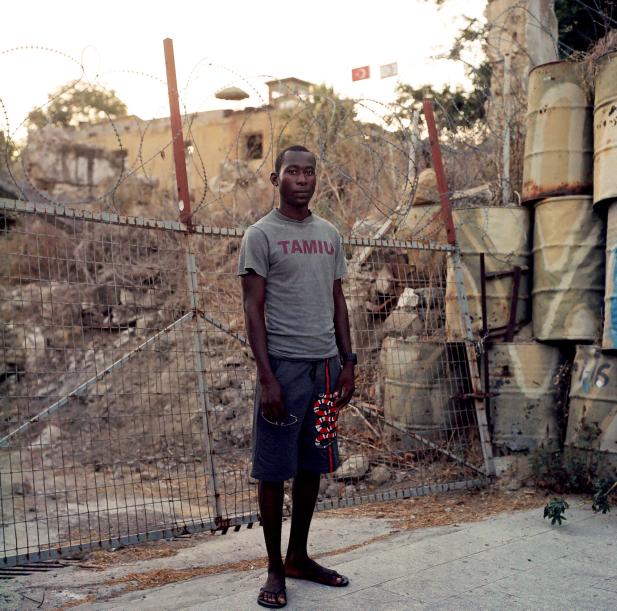

Nicosia, Cyprus. August 2020. “N”, a migrant from Congo, poses for a portrait in front of one of the UN-Buffer zone walls separating the Republic of Cyprus and the TRNC. The city of Nicosia is the last divided city in Europe, split roughly in the middle by the UN-patrolled Buffer Zone. N left Congo in search of better opportunities and the possibility to study in Europe. After arriving in the Turkish Republic of Northern Cyprus, a "de-facto" state solely recognized by Turkey, he realized he had been duped by unscrupulous agents in Africa and had no more money to pay for his fees and continue his education. He used whatever money had left to pay coyotes to take him across the border to Cyprus. He spent 4 months in the Pournara Emergency Reception Centre in squalid conditions. He is now waiting for his UNCHR interview in the hopes of being able to work freely and be resettled somewhere else.
Cyprus, still reeling from the effects of the 1974 Greek-led coup and the subsequent Turkish invasion that divided the island into two communities, Greek, and Turkish-Cypriots must now deal with an influx of refugees that threatens to change the island’s demographics.
“It’s like being in a prison, only that you are able to move freely but with nothing to do,” Raymond, Sierra Leone, asylum seeker.
Cyprus, still reeling from the effects of the 1974 Greek-led coup and the subsequent Turkish invasion that divided the island into two communities, Greek, and Turkish-Cypriots must now deal with an influx of refugees that threatens to change the island’s demographics.
With a population of around 850,000, Cyprus holds the largest share of asylum-seekers per capita, 3.5%, in all of Europe. The influx of Syrians fleeing the war, the largest group of refugees, is slowly giving way to a host of asylum seekers from Africa.
In the last 5 months of 2022, more than 10,000 asylum seekers have submitted their asylum claims in the Republic of Cyprus. There were more asylum applications than births in Cyprus in 2021.
The arrivals, along with an already broken system, threaten to upend the fragile peace that has been holding since 1974. As one side tries to derail the other by sending them across the border, migrants suffer while waiting in limbo, victims of racism, and extortion by landlords and employers, with no prospects for a better life.
Trekking their way along the porous UN-Buffer zone that separates the Republic of Cyprus and the Turkish Republic of North Cyprus (TRNC), a “de-facto” country solely recognized by Turkey, they end up in neglected camps that are meant to house them only for a few days but often end up spending weeks and months there.
The paths that they use to cross into the Republic of Cyprus are a historical loophole that never offered any opportunity until today. Refugees first enter the TRNC on the basis of studying and working in Europe. Once they realize they are not in Europe and that they have been duped by the Universities and agents at home, they are forced to find a way to enter Europe by crossing into the remaining two-thirds of the island, the Republic of Cyprus.
African migrants who dream of reaching Europe, studying, and working end up living in squalid conditions in Cyprus, unable to leave the island and unwilling to return home for fear of having “failed” their dreams. They must contend with a country that does not want them here and that makes no effort to integrate them and offer them jobs and decent living conditions.
How will this migration reshape the island and how will Cypriots and refugees learn to deal with this new reality is a question that will linger for many years to come.
UNHCR
Radu Diaconu
4551 Euclide Brien
Montreal, Qc, Canada
H1X 3K4
5146132652
Make Comment/View Comments